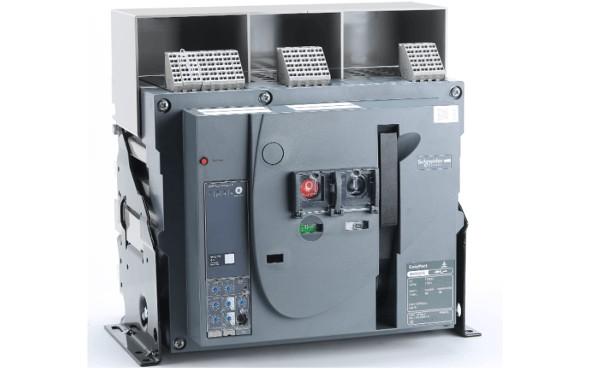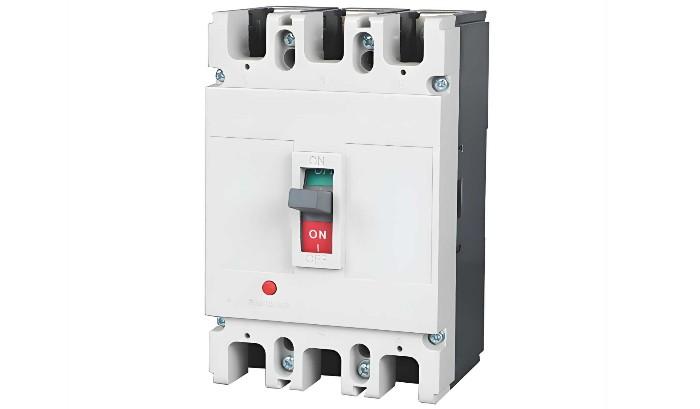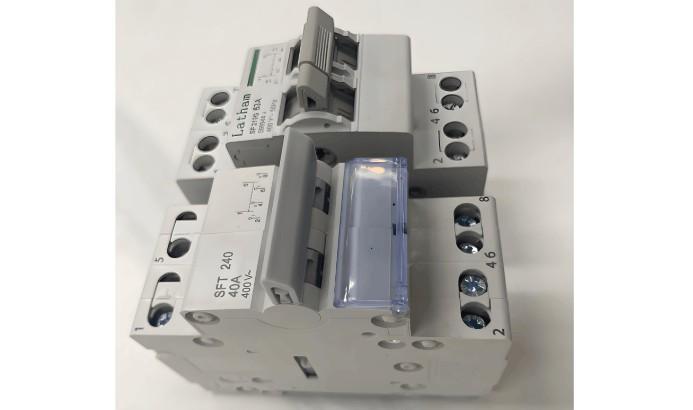Klasipikasyon ng mga Circuit Breaker
(1) Air Circuit Breaker (ACB)
Ang air circuit breaker, na kilala rin bilang molded frame o universal circuit breaker, ay naglalaman ng lahat ng komponente sa loob ng isang nakaisulat na metal na frame. Karaniwang bukas ang disenyo nito, na nagbibigay-daan para sa pag-install ng iba't ibang mga accessory, at nagpapadali ng pagpalit ng mga contact at bahagi. Karaniwang ginagamit ito bilang pangunahing switch ng suplay ng kuryente. Ang mga overcurrent trip units ay kasama ang electromagnetic, electronic, at intelligent types. Nagbibigay ang breaker ng apat na yugto ng proteksyon: long-time delay, short-time delay, instantaneous, at ground fault protection. Ang bawat setting ng proteksyon ay maaaring i-adjust sa isang range batay sa laki ng frame.
Ang mga air circuit breakers ay angkop para sa AC 50Hz, na may rated voltages ng 380V o 660V, at rated currents mula 200A hanggang 6300A sa mga network ng distribution. Ginagamit sila pangunahin upang mag-distribute ng enerhiya at protektahan ang mga circuit at power equipment mula sa overloads, undervoltage, short circuits, single-phase grounding, at iba pang mga kaputanan. Ang mga breaker na ito ay nagbibigay ng maraming intelligent protection functions at nagbibigay ng selective protection. Sa normal na kondisyon, maaari silang gamitin para sa infrequent switching ng mga circuit. Ang mga ACBs na may ratings hanggang 1250A ay maaaring gamitin sa AC 50Hz, 380V networks upang protektahan ang mga motor mula sa overload at short circuits.

Ang mga air circuit breakers ay karaniwang ginagamit din bilang main switches sa 400V side ng mga transformer, bus tie switches, high-capacity feeder switches, at large motor control switches.
(2) Molded Case Circuit Breaker (MCCB)
Tinatawag din itong plug-in circuit breaker, ang molded case circuit breaker ay naglalaman ng mga terminal, contacts, arc extinguishing chambers, trip units, at operating mechanisms sa loob ng isang plastic enclosure. Ang auxiliary contacts, undervoltage trip units, at shunt trip units ay madalas modular. Ang struktura ay kompakto, at hindi karaniwan ang maintenance. Ito ay angkop para sa branch circuit protection. Ang mga molded case breakers ay karaniwang kasama ang thermal-magnetic trip units, habang ang mas malalaking modelo ay maaaring ma-equipped ng solid-state trip sensors.
Ang mga overcurrent trip units para sa MCCBs ay available sa electromagnetic at electronic types. Karaniwang non-selective ang mga electromagnetic MCCBs at nagbibigay lamang ng long-time delay at instantaneous protection. Ang mga electronic MCCBs ay nagbibigay ng apat na function ng proteksyon: long-time delay, short-time delay, instantaneous, at ground fault protection. Ang ilang bagong ipinakilalang electronic MCCBs ay may feature din ng zone-selective interlocking.

Ang mga molded case circuit breakers ay karaniwang ginagamit para sa feeder circuit control at proteksyon, main switches sa low-voltage side ng maliliit na mga distribution transformers, terminal power distribution control, at bilang mga power switches para sa iba't ibang mga production machinery.
(3) Miniature Circuit Breaker (MCB)
Ang miniature circuit breaker ay ang pinaka-widely used na terminal protection device sa mga building electrical terminal distribution systems. Ginagamit ito para sa proteksyon laban sa short circuits, overloads, at overvoltage sa single-phase at three-phase circuits hanggang 125A, at may mga configuration na single-pole (1P), double-pole (2P), triple-pole (3P), at four-pole (4P).
Ang MCB ay binubuo ng operating mechanism, contacts, protective devices (iba't ibang trip units), at arc extinguishing system. Ang mga main contacts ay isinasara manual o electrically. Pagkatapos ng pagsasara, ang free-tripping mechanism ay nakakakilit sa mga contacts sa closed position. Ang coil ng overcurrent trip unit at ang heating element ng thermal trip unit ay konektado sa serye sa main circuit, habang ang coil ng undervoltage trip unit ay konektado sa parallel sa power supply.

Sa civil building electrical design, ang mga miniature circuit breakers ay pangunahing ginagamit para sa proteksyon at operasyon tulad ng overload, short circuit, overcurrent, loss of voltage, undervoltage, grounding, leakage, automatic transfer of dual power sources, at infrequent motor starting.
Basic Characteristic Parameters ng Circuit Breakers
(1) Rated Operating Voltage (Ue)
Ang rated operating voltage ay ang nominal voltage ng circuit breaker, kung saan maaaring mag-operate continuous ang breaker sa ilalim ng specified normal service at performance conditions.
Sa Tsina, para sa mga voltage levels hanggang 220kV, ang maximum operating voltage ay 1.15 times ang system rated voltage; para sa 330kV at ibabaw, ang maximum operating voltage ay 1.1 times ang rated voltage. Ang circuit breaker ay kailangang panatilihin ang insulation at maaaring mag-close at interrupt sa ilalim ng system's maximum operating voltage.
(2) Rated Current (In)
Ang rated current ay ang current na maaaring carry continuous ng trip unit sa ambient temperature na mas mababa sa 40°C. Para sa mga breakers na may adjustable trip units, tumutukoy ito sa maximum current na maaaring carry continuous ng trip unit.
Kapag ginamit sa ambient temperatures na mas mataas sa 40°C ngunit hindi lumampas sa 60°C, maaaring mag-operate ang breaker sa reduced load para sa long-term service.
(3) Overload Trip Current Setting (Ir)
Kapag lumampas ang current sa setting ng trip unit na Ir, ang circuit breaker ay trip after a time delay. Ito rin ang kinakatawan ng maximum current na maaaring carry ng breaker nang walang trip. Ang value na ito ay kailangang mas mataas sa maximum load current Ib ngunit mas mababa sa maximum allowable current Iz ng circuit.
Para sa thermal-magnetic trip units, ang Ir ay karaniwang adjustable sa 0.7–1.0In. Para sa electronic trip units, ang adjustment range ay karaniwang mas malawak, na karaniwang 0.4–1.0In. Para sa mga breakers na may non-adjustable overcurrent trip units, Ir = In.
(4) Short-Circuit Trip Current Setting (Im)
Ang short-circuit trip unit (instantaneous o short-time delay) ay nagdudulot ng trip ng circuit breaker nang mabilis kapag may mataas na fault currents. Ang trip threshold nito ay Im.
(5) Rated Short-Time Withstand Current (Icw)
Ito ang current value na pinapayagan na lumampas sa conductor sa isang tinukoy na duration nang hindi nagdudulot ng pinsala dahil sa sobrang init.
(6) Breaking Capacity
Ang breaking capacity ng circuit breaker ay tumutukoy sa kanyang kakayahan na safely interrupt fault currents, na hindi kinakailangang may kaugnayan sa kanyang rated current. Common ratings include 36kA at 50kA. Karaniwang hinahati ito sa ultimate short-circuit breaking capacity (Icu) at service short-circuit breaking capacity (Ics).
General Principles para sa Circuit Breaker Selection
Una, pumili ng tipo at bilang ng poles batay sa application; pagkatapos, pumili ng rated current batay sa maximum operating current; sa huli, pumili ng tipo ng trip unit at accessories. Ang specific requirements ay sumusunod:
Ang rated operating voltage ng circuit breaker ≥ line rated voltage.
Ang rated short-circuit making/breaking capacity ng circuit breaker ≥ calculated load current ng line.
Ang rated short-circuit making/breaking capacity ng circuit breaker ≥ maximum possible short-circuit current sa line (karaniwang ina-compute bilang RMS value).
Single-phase-to-ground short-circuit current sa dulo ng line ≥ 1.25 times ang instantaneous (o short-time delay) trip setting ng circuit breaker.
Ang rated voltage ng undervoltage trip unit = line rated voltage.
Ang rated voltage ng shunt trip unit = control power supply voltage.
Ang rated operating voltage ng electric operating mechanism = control power supply voltage.
Kapag ginamit sa lighting circuits, ang instantaneous trip setting ng electromagnetic trip unit ay karaniwang 6 times ang load current.
Kapag ginamit ang circuit breaker para sa short-circuit protection ng single motor, ang instantaneous trip setting ay 1.35 times ang motor starting current (para sa DW series) o 1.7 times (para sa DZ series).
Kapag ginamit ang circuit breaker para sa short-circuit protection ng multiple motors, ang instantaneous trip setting ay 1.3 times ang starting current ng pinakamalaking motor plus ang operating currents ng natitirang motors.
Kapag ginamit ang circuit breaker bilang main switch sa low-voltage side ng distribution transformer, ang breaking capacity nito ay dapat lumampas sa short-circuit current sa low-voltage side ng transformer. Ang trip unit’s rated current ay hindi dapat mas mababa sa rated current ng transformer. Ang short-circuit protection setting ay karaniwang 6–10 times ang rated current ng transformer; ang overload protection setting ay equal sa rated current ng transformer.
Pagkatapos ng preliminary selection ng circuit breaker type at rating, kailangan ng coordination sa upstream at downstream protective devices upang maiwasan ang cascading tripping at minimize ang saklaw ng aksidente.
Selectivity ng Circuit Breakers
Sa mga distribution systems, ang mga circuit breakers ay classify bilang selective o non-selective batay sa performance ng proteksyon. Ang selective low-voltage circuit breakers ay may dalawang-stage o tatlong-stage ng proteksyon. Ang instantaneous at short-time delay characteristics ay ginagamit para sa short-circuit protection, habang ang long-time delay characteristics ay ginagamit para sa overload protection. Ang non-selective breakers ay karaniwang instantaneous, ginagamit lamang para sa short-circuit protection, o long-time delay, ginagamit lamang para sa overload protection.
Sa mga distribution systems, kung ang upstream breaker ay selective at ang downstream breaker ay non-selective o selective, ang selectivity ay nakuha sa pamamagitan ng paggamit ng time delay ng short-time delay trip unit o differences sa time delay settings. Kapag ang upstream breaker ay nag-operate sa time delay, konsiderin ang mga sumusunod:
Anuman ang downstream breaker ay selective o non-selective, ang instantaneous overcurrent trip setting ng upstream breaker ay karaniwan ay hindi bababa sa 1.1 times ang maximum three-phase short-circuit current sa output ng downstream breaker.
Kung ang downstream breaker ay non-selective, upang maiwasan ang upstream short-time delay overcurrent trip unit mula gumana unang-una dahil sa insufficient sensitivity ng downstream instantaneous trip unit sa panahon ng short circuit, ang short-time delay overcurrent trip setting ng upstream breaker ay karaniwan ay hindi bababa sa 1.2 times ang downstream breaker’s instantaneous trip unit.
Kung ang downstream breaker ay din selective, upang matiyak ang selectivity, ang short-time delay operating time ng upstream breaker ay dapat na hindi bababa sa 0.1 seconds mas mahaba kaysa sa downstream breaker.
Karaniwan, upang matiyak ang selective operation sa pagitan ng upstream at downstream low-voltage circuit breakers, ang upstream breaker ay dapat na may short-time delay overcurrent trip unit, at ang kanyang operating current ay dapat na mas mataas ng isang level kaysa sa downstream trip unit. Sa minimum, ang upstream operating current Iop.1 ay hindi dapat mas mababa sa 1.2 times ang downstream operating current Iop.2, i.e., Iop.1 ≥ 1.2Iop.2.
Cascading Protection ng Circuit Breakers
Sa distribution system design, ang coordination sa pagitan ng upstream at downstream circuit breakers ay kailangang makamit ang "selectivity, speed, at sensitivity." Ang selectivity ay may kaugnayan sa coordination sa pagitan ng breakers, habang ang speed at sensitivity ay kaugnay ng characteristics ng protective device at operating mode ng circuit.
Ang tamang coordination sa pagitan ng upstream at downstream breakers ay nagbibigay-daan para sa selective isolation ng faulty circuit, na nagpapatuloy ng normal na operasyon ng iba pang non-faulty circuits. Ang mahinang coordination ay nakakaapekto sa reliability ng sistema.
Ang cascading protection ay isang praktikal na aplikasyon ng current-limiting characteristics ng mga circuit breakers. Ang pangunahing prinsipyong ito ay ang paggamit ng current-limiting effect ng upstream breaker (QF1), na nagbibigay-daan sa pagpili ng downstream breaker (QF2) na may mas mababang breaking capacity, na nagbabawas ng cost. Ang current-limiting upstream breaker QF1 ay maaaring interrupt ang maximum prospective short-circuit current sa installation point nito. Dahil connected sa series ang upstream at downstream breakers, kapag may short circuit sa output ng downstream breaker QF2, ang aktwal na short-circuit current ay significantly nababawasan ng current-limiting effect ng QF1, na malayo sa prospective short-circuit current sa punto na iyon. Kaya, ang breaking capacity ng QF2 ay effectively enhanced ng QF1, na lumalampas sa kanyang rated breaking capacity.
Mayroon ang cascading protection ng ilang kondisyon: halimbawa, ang adjacent circuits ay hindi dapat may critical loads (dahil ang tripping ng QF1 ay maaaring de-energize ang circuit ng QF3), at ang instantaneous settings ng QF1 at QF2 ay dapat na tama ang match. Ang cascading data ay maaaring matukoy lamang sa pamamagitan ng eksperimento, at ang coordination sa pagitan ng upstream at downstream breakers ay dapat ibigay ng manufacturer.
Sensitivity ng Circuit Breakers
Upang matiyak ang reliable operation ng instantaneous o short-time delay overcurrent trip unit sa minimum system operating conditions at sa mildest short-circuit fault sa loob ng kanyang proteksyon range, ang sensitivity ng circuit breaker ay kailangang tugunan ang requirements ng "Low-Voltage Electrical Distribution Design Code" (GB50054-95), na nagtatakda ng sensitivity na hindi bababa sa 1.3, i.e., Sp = Ik.min / Iop ≥ 1.3. Dito, ang Iop ay ang operating current ng instantaneous o short-time delay overcurrent trip unit, ang Ik.min ay ang single-phase o two-phase short-circuit current sa dulo ng protected line sa ilalim ng minimum system operating conditions, at ang Sp ay ang sensitivity ng circuit breaker.
Kapag pumili ng circuit breaker, ang kanyang sensitivity ay dapat ring i-verify. Para sa selective breakers na may short-time delay at instantaneous overcurrent trip units, kailangang i-check lang ang sensitivity ng short-time delay trip unit; ang sensitivity ng instantaneous trip unit ay hindi kailangang i-verify.
Selection at Setting ng Circuit Breaker Trip Units
(1) Setting ng Instantaneous Overcurrent Trip Unit Operating Current
Ang ilang electrical equipment na protektahan ng circuit breaker ay may mataas na peak currents sa panahon ng startup, ilang beses ang rated current, na nagdudulot ng breaker na makaranas ng mataas na peak currents nang maikling panahon. Ang operating current Iop(o) ng instantaneous overcurrent trip unit ay dapat lumampas sa peak current ng circuit Ipk, i.e., Iop(o) ≥ Krel·Ipk, kung saan ang Krel ay ang reliability factor. Kapag pumili ng circuit breaker, tiyakin na ang kanyang instantaneous overcurrent trip setting ay lumampas sa peak current upang maiwasan ang nuisance tripping.
(2) Setting ng Short-Time Delay Overcurrent Trip Unit Operating Current at Time
Ang operating current Iop(s) ng short-time delay overcurrent trip unit ay dapat din lumampas sa peak current ng circuit Ipk, i.e., Iop(s) ≥ Krel·Ipk, kung saan ang Krel ay ang reliability factor. Ang short-time delay trip times ay karaniwan 0.2s, 0.4s, o 0.6s, na inuukol batay sa selectivity sa upstream at downstream protection devices, na nagpapatiyak na ang upstream device ay gumagana nang mas huli kaysa sa downstream sa isang time step.
(3) Setting ng Long-Time Delay Overcurrent Trip Unit Operating Current at Time
Ang long-time delay overcurrent trip unit ay pangunahin ginagamit para sa overload protection. Ang operating current Iop(l) nito ay kailangang lumampas lamang sa maximum load current ng circuit (calculated current I30), i.e., Iop(l) ≥ Krel·I30, kung saan ang Krel ay ang reliability factor. Ang operating time ay dapat lumampas sa duration ng allowable short-term overloads upang maiwasan ang nuisance tripping.
(4) Coordination Requirements sa pagitan ng Overcurrent Trip Unit Operating Current at Protected Circuit
Upang maiwasan ang damage sa insulation o sunog dahil sa overloads o short circuits nang walang circuit breaker tripping, ang overcurrent trip unit’s operating current Iop ay kailangang tugunan ang condition: Iop ≤ Kol·Ial. Dito, ang Ial ay ang allowable current-carrying capacity ng insulated cable; ang Kol ay ang allowable short-term overload factor—karaniwang 4.5 para sa instantaneous at short-time delay trip units, 1.1 para sa long-time delay trip units na ginagamit para sa short-circuit protection, at 1.0 kung ginagamit lamang para sa overload protection. Kung hindi tugunan ang coordination requirement na ito, ang trip unit setting ay dapat i-adjust, o ang cross-section ng conductor o cable ay dapat palakihin nang angkop.
























